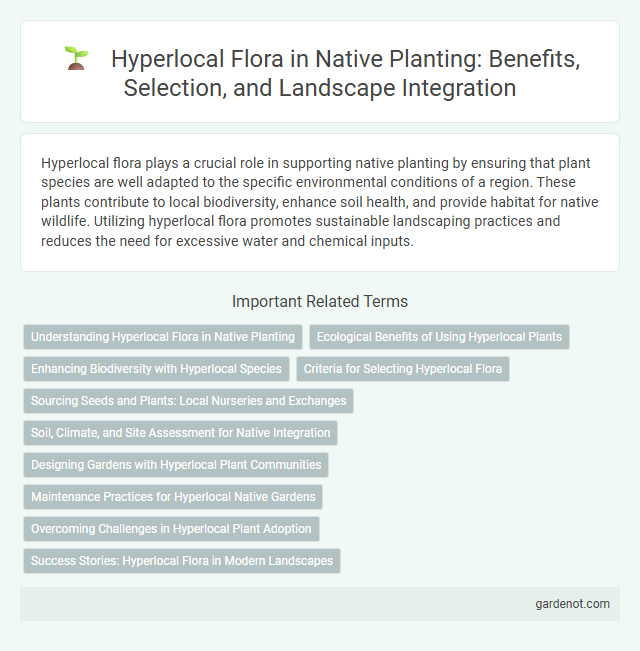Hyperlocal flora plays a crucial role in supporting native planting by ensuring that plant species are well adapted to the specific environmental conditions of a region. These plants contribute to local biodiversity, enhance soil health, and provide habitat for native wildlife. Utilizing hyperlocal flora promotes sustainable landscaping practices and reduces the need for excessive water and chemical inputs.
Understanding Hyperlocal Flora in Native Planting
Hyperlocal flora refers to plant species that are indigenous to a very specific geographic area, often within a few square miles, making them highly adapted to local soil, climate, and ecosystem conditions. Understanding hyperlocal flora in native planting enhances biodiversity, supports native pollinators, and promotes ecological resilience by using plants uniquely suited to the microhabitat. Selecting these plants ensures sustainable landscaping, conserves water, and reduces the need for fertilizers and pesticides due to their natural compatibility with the local environment.
Ecological Benefits of Using Hyperlocal Plants
Utilizing hyperlocal flora enhances biodiversity by supporting native pollinators, birds, and beneficial insects adapted to local conditions. These plants improve soil health through natural nutrient cycling and increased microbial activity, reducing the need for chemical fertilizers. Hyperlocal vegetation also aids in water conservation by thriving with minimal irrigation, promoting sustainable landscape practices.
Enhancing Biodiversity with Hyperlocal Species
Incorporating hyperlocal flora into native planting strategies significantly enhances biodiversity by supporting local ecosystems and wildlife adapted to specific environmental conditions. Native plant species promote soil health, conserve water, and provide habitat for pollinators such as bees and butterflies, boosting ecosystem resilience. Utilizing hyperlocal species reduces the risk of invasive plants overtaking landscapes and ensures sustainable, ecologically balanced green spaces.
Criteria for Selecting Hyperlocal Flora
Choosing hyperlocal flora involves assessing native species that naturally thrive in specific microclimates and soil conditions of an area, ensuring ecological compatibility. Prioritizing plants with strong adaptability to local rainfall patterns and temperature ranges boosts survival rates and supports native wildlife. Selecting flora based on their role in preserving local biodiversity and enhancing habitat connectivity optimizes ecosystem resilience and sustainability.
Sourcing Seeds and Plants: Local Nurseries and Exchanges
Sourcing seeds and plants from local nurseries and plant exchanges ensures the preservation of hyperlocal flora adapted to specific climate and soil conditions. Native plants sourced locally promote biodiversity, support pollinators, and enhance ecosystem resilience within the region. Engaging with community seed exchanges fosters genetic diversity and strengthens conservation efforts for native plant species.
Soil, Climate, and Site Assessment for Native Integration
Hyperlocal flora selection thrives on thorough soil, climate, and site assessment to ensure native plants establish successfully. Understanding soil pH, texture, and nutrient content alongside microclimatic factors such as sunlight exposure, temperature range, and moisture levels enables tailored native plant integration. Accurate site evaluation promotes biodiversity, enhances ecosystem resilience, and supports sustainable landscape health through native planting strategies.
Designing Gardens with Hyperlocal Plant Communities
Designing gardens with hyperlocal plant communities enhances biodiversity by incorporating native species uniquely adapted to the specific microclimate, soil, and ecosystem of the area. Utilizing hyperlocal flora supports local pollinators, improves soil health, and reduces water consumption through plants inherently suited to regional rainfall patterns. Integrating these native plant communities creates sustainable, resilient landscapes that foster ecological balance and preserve natural heritage.
Maintenance Practices for Hyperlocal Native Gardens
Effective maintenance practices for hyperlocal native gardens emphasize seasonal pruning, mulching with organic materials, and targeted watering techniques to preserve soil moisture and promote root health. Regular removal of invasive species ensures native plants receive optimal nutrients and sunlight, supporting biodiversity and ecological balance. Incorporating composting and soil testing further enhances nutrient cycling and plant vigor tailored to localized environmental conditions.
Overcoming Challenges in Hyperlocal Plant Adoption
Hyperlocal flora selection enhances biodiversity by using native plant species adapted to specific microclimates, improving ecosystem resilience and sustainability. Overcoming challenges in hyperlocal plant adoption involves addressing soil variability, local pests, and community awareness through targeted education and soil amendments. Integrating traditional ecological knowledge with modern horticultural practices accelerates acceptance and success of native plantings in urban and suburban microhabitats.
Success Stories: Hyperlocal Flora in Modern Landscapes
Hyperlocal flora has transformed modern landscapes by enhancing biodiversity while supporting local ecosystems with native plant species uniquely adapted to their environment. Success stories highlight urban parks and residential gardens where native plants have improved soil health, supported pollinators, and reduced water usage. These projects demonstrate the ecological and aesthetic benefits of integrating hyperlocal flora in sustainable landscape design.
Hyperlocal flora Infographic

 gardenot.com
gardenot.com